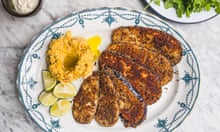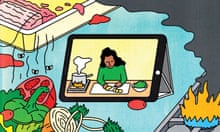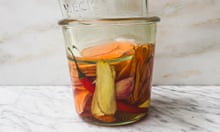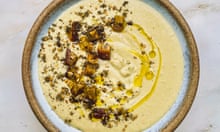Shoppers’ appetite for salmon is causing millions of tonnes of nutritious mackerel, sardines and anchovies to be wasted as fish feed, according to new research.
Its authors say farming salmon is an inefficient way to produce nutritious seafood, calculating that half to 99% of minerals, vitamins and fatty acids in the wild-caught fish are not retained when fed to farmed Atlantic salmon.
They say removing wild-caught fish from aquaculture feed production and diverting them to human consumption, and farming more carp and fewer salmon, could increase global seafood production by 6.1m tonnes, while leaving 3.7m tonnes of fish in the sea.
Lia ní Aodha, of Feedback Global, which worked on the report said: “Salmon farming is a good example of how deeply inefficient and inequitable the global food system is. Much of the nutrient-rich fish used to feed farmed salmon is sourced from regions in the global south, where food insecurity is endemic, while the salmon is mainly sold to consumers in high-income markets in Europe, North America and parts of Asia.”
Feedback, which campaigns for sustainable food supplies, worked with researchers from the universities of Cambridge, Lancaster and Liverpool to investigate feed sources – and the nutrients transferred from them – in the Scottish salmon industry, Britain’s largest food export. They calculated that in a single year, 179,000 tonnes of salmon produced in Scottish aquaculture farms consumed fish meal and fish oil produced from 460,000 tonnes of wild-caught fish, 76% of which was edible.
In their paper, published on the research forum Plos Sustainability and Transformation, they said: “Most edible wild-caught fish species in [fish meal and fish oil] have higher concentrations of key micronutrients than farmed salmon, and for some of these micronutrients, as little as 1% is retained in farmed salmon.
“For calcium, iron, selenium and zinc, 1-28% is retained in farmed salmon. Scottish salmon is often marketed as high in omega-3 fatty acids (EPA and DHA), yet omega-3 concentrations are similar in anchovy, herring, sardine and sprat, and only 49% and 39% of DHA available from wild fish are retained in farmed salmon.”
In 2016, 15m tonnes of wild-caught fish were ground down into fish meal and fish oil, which was directed towards agriculture and aquaculture. According to figures cited in the paper, salmon fishing accounted for 60% of fish oil and 23% of fish meal directed to aquaculture, while producing only 4.5% of the sector’s global output.
Authors still saw a role for aquaculture, but favoured carp and mussel farming over salmon.
Dr James Robinson, of Lancaster university, who was involved in the study, said: “Aquaculture, including salmon farming, has an important role in meeting global food demand, but nutritious wild fish should be prioritised for local consumption rather than salmon feed, particularly if they are caught in food-insecure places.
“Support for alternative feeds can help this transition, but we still need more data on the volumes and species used for fishmeal and fish oil, as this can show where salmon farming places additional pressure on fish stocks.”
Hamish Macdonell, director of strategic engagement with Salmon Scotland, which represents salmon farmers, said: “Of the 5.5m tonnes of fish meal and fish oil produced annually, Scottish salmon farmers use less than 1%. The vast majority goes to other uses, including pet food.
“So it is fundamentally wrong to pretend that the fishmeal industry would cease if not included in aquaculture feeds. The supply would simply shift to another, less sustainable use. If campaigners like the ones behind this report really want to do something to save forage fish, they should take a look at what we all feed our pets.”










